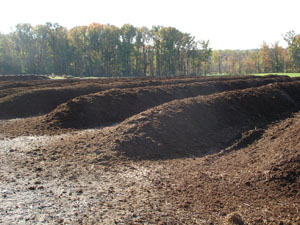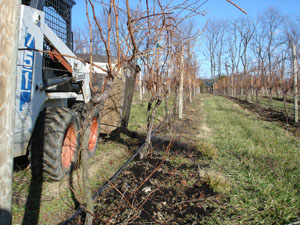Compost as Fertilizer Types Amount of Application Application Methods & Timing More Info
Fritz Westover, Texas AgriLife Extension
Compost is applied to agricultural soils for a number of reasons:
- to provide nutrients for plant growth,
- to increase soil organic matter,
- to alter soil structure, and
- to mitigate soil erosion.
The effects of a compost application on plant growth can continue over multiple seasons. Therefore, the rate of compost applied to a vineyard depends upon the goal of the grape grower, and is often limited by the nutrient content of the compost.
Compost as Fertilizer
Compost is most commonly applied in vineyards as a fertilizer. Grapevines generally require less fertilization than many other agricultural crops, as growers are seeking to find a balance of vegetative growth and fruit yield. Too much nitrogen fertilization for example, can lead to excessive vegetative growth, poor fruit production, and poor winter acclimation in some climates. It is important to know the nutritional analysis of a finished compost prior to deciding the application rate, or determining if it is the most appropriate source of fertilizer. A grower who wishes to apply only a small amount of potassium or phosphorous may do so by fertilizing with a commercial fertilizer containing those specific nutrients; however, most compost contains a wide range of macro and micronutrients, including nitrogen, phosphorous, potassium, calcium, magnesium, boron, iron, copper, and manganese. Compost could therefore be considered a “complete” fertilizer, which should only be used in situations where all of its nutritional components are desired.
Types of Compost
Many types of compost are available through commercial producers. The most common types are typically a mixture of animal manure and straw bedding, mulched yard trimmings or leaf litter, or miscellaneous food and fiber waste. In some instances, growers choose to create custom compost blends from on-farm resources or winery waste, such as grape pomace. The microbial process of turning raw stock materials into finished compost requires time, moisture, air, and a sustained temperature of 130 to 140 degrees Fahrenheit for enough time to kill off weed seeds and human and plant pathogens.
Understanding the differences between finished and raw compost is important because this will influence its usefulness. Organic material that has not gone through a thorough composting process may contain weed seeds, plant pathogens, and unpleasant odors. Nutrient availability from raw manure is generally not as predictable as that of composted manure, and if applied, could result in excess availability of salts and leaching of nutrients. Finished compost will be of uniform color and texture, have neutral to earthy odor, and a carbon to nitrogen ratio less than 20. The type of compost growers apply in the vineyard will often depend upon local availability, hauling considerations, and suitability of compost for spreading with machinery.
Amount of Application
Just as with other fertilizer products, it is important to understand the rate of fertilizer desired and the availability of the fertilizer for uptake into vines, prior to determining application rates. Compost application rates in vineyards are dependent upon the nutrient content of the compost and the amount of those nutrients required per acre or per plant, according to plant and soil analyses. Before determining rates of application it is advisable to have the most recent results of petiole or leaf nutrient analysis, soil nutrient analysis, and the nutrient analysis of the compost to be applied. Compost producers may have an analysis available, and most state or university soil laboratories can test plant and soil samples for a fee. In general, application rates of compost are limited to the rate of nitrogen desired, because nitrogen tends to stimulate vegetative growth more than other nutrients. If vine growth is adequate or more vigorous than desired, and soil and petiole tests show adequate nitrogen, then adding compost may exacerbate the problem. If nitrogen levels are low and vine growth is less than desired, a measured application of compost may be beneficial.
Approximately 30% of the total nitrogen in compost becomes available to vines over time; about 15% in the first year and the remaining 15% over the next 3 to 4 years. For example, an application of 10 tons of compost containing 20 lbs per ton of nitrogen would therefore provide 30 lbs of nitrogen per acre in the first year plus an additional 30 lbs over the next 4 years. Growers that are have not applied compost before may be surprised to see that an application of 10 tons of compost per acre is barely visible on the soil surface, hence an application rate needed to cover the soil completely would likely result in over-fertilization of vines. It is essential to observe the effects of the first compost application on vine growth and grape quality before determining the need and rate of future applications.
Application Methods and Timing
Application methods differ depending upon compost rates and vineyard design. Application in small vineyards or in small sections of vineyards can be accomplished by hand. Uniform surface application over the entire vineyard floor can be accomplished with a broadcast manure spreader prior to planting a vineyard, or in an existing vineyard, provided the equipment can fit into the vine rows. Mulch spreading machines may also offer the option for band application of compost in situations where a grower wishes only to fertilize the area under the vine row. Compost is typically applied in the fall, just after harvest, or early in the spring, just before bud break, as mid season applications can often result in undesired vine vigor late in the growing season, potentially compromising grape quality and winter acclimation.
Mulch spreader attached to front of bobcat is used to band apply compost (L) and pulled behind tractor as compost is banded under vine rows. Photos by Fritz Westover, Texas AgriLife Extension.
Recommended Resources
A Practical Guide to the Application of Compost in Vineyards, Penn State University
Notes on Composting Grape Pomace, Virginia Tech
A Practical Guide to the Application of Compost in Vineyards, Cornell University
Reviewed by Tim Martinson, Cornell University and Tim Weigle, NYS IPM Program, Cornell University



